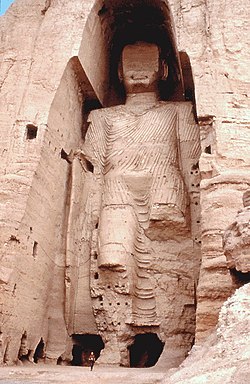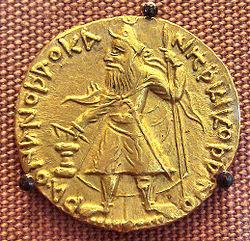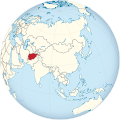Wikijunior:Asia/Afghanistan
| This page may need to be updated to reflect current knowledge. You can help update it, discuss progress, or request assistance. |





Afghanistan (Pashto/Dari: افغانستان), officially the Islamic Republic of Afghanistan, is a landlocked country in the Middle East. Afghanistan has a population of 32 million people, making it the 42nd most populated country in the world. The country's strategic location along the Silk Road allowed Afghanistan to have significant interactions with other cultures in the Middle East and other parts of Asia, justifying Afghanistan's extreme diversity.
Afghanistan's history spans over thousands and thousands of years. Records show that Afghanistan was home to many settlers that had fixed settlements accompanied by farming and the use of domesticated crops/animals (known as the Neolithic Era, final phase of the Stone Age). These settlements eventually grew to be massive civilizations. Eventually, Zoroastrianism flourished throughout Afghanistan with the oncoming of the Yaz culture from about 1500 BCE to 1100 BCE. Historians say that the lack of burials founded in relation to the Yaz Culture correlates to the Zoroastrian belief of sky burials, which is where a human body (after death) is left at the top of a mountain to be taken away by "natural elements" (scavengers, wind, rain, etc.). After invasions by the Persians (in 6th century BCE) and Alexander the Great (in 4th century BCE), Buddhism and Hinduism took over as the major religion with the arrival of the Mauryan Indians from the Indian subcontinent. In the 7th century, Islam took over Afghanistan when Arab Muslims arrived. What followed afterwards were several centuries of Islamic ruling by various Islamic dynasties, such as the Saffarid and Ghurid dynasties.
Eventually, the British attempted to keep Afghanistan under long British ruling, with a couple of wars between the two parties. By 1919, the country was completely free of British influences. A monarchy was created promptly afterwards, which lasted until 1973 when political crises forced the king out of his power (a coup took place). A republic, non-religious government was established until the Soviets invaded Afghanistan in 1979 after a Soviet-backed political party took over the government, sparking outrage and violent protests throughout the nation. The Soviets were met with the fierce fighting of the Mujahideen rebels, who were soldiers trained in neighbouring Pakistan to fight against the Soviets. The Soviet-Afghan war ended in February of 1989, resulting in the withdrawal of the Soviet troops. Various Afghan tribes started fighting each other for power over the nation, with the Taliban (Islamic militant group) emerging victorious over the other tribes in the 90s. They ruled with an iron fist, adhering to their strict version of the Islamic faith.
The Taliban were harshly criticized for their inhumane and cruel punishments and their severe restrictions on women's rights. They ruled the whole nation until the US invasion of Afghanistan in 2001 (occurring right after the 9/11 attacks), in which they were partially dethroned. This has caused conflicts between the Taliban and the Afghan government, resulting in many innocent civilian casualties over the past two decades. Although still facing many issues with the Taliban, Afghanistan improved tremendously ever since the partial dethronement of the Taliban, with improved women's rights and educational standards. This ended when they returned to power in 2021.
Its capital and largest city is Kabul and the the currency is the Afghan Afghani.
Where is Afghanistan?
[edit | edit source]
Afghanistan is located in Central and Southern Asia. It borders Iran towards the west, Pakistan towards the south and east, Tajikistan, Turkmenistan, Uzbekistan to the north, and China towards the northeast. The country's location gave away to many important and beneficial trade routes, including the Silk Road.
How many people live in Afghanistan?
[edit | edit source]
The population, as of 2020, is reported to be at 38 million people (including 3 million Afghanis living in Pakistan and Iran). In 2017, out of a population of 29 million people, 15 million were reported to be male and 14.2 million were reported to be female. Majority of Afghanis live in rural areas (a lot of land, very little peope). Life expectancy averages are reported to be about 60.5 years.
The Afghan Constitute mentions 14 ethnic groups, including but not limited to: Pashtun, Tajik, Hazara, Uzbek, Aymāq, Turkmen, Baloch, Pashai, Nuristani, Gujjar, Arab, Brahui, Pamiri and Kyrgyz. The biggest ethnic group of Afghanistan is the Pashtun, who take up about 40% of the total population. They are primarily located between the Hindu Kush mountains (northeastern Afghanistan). and the Indus River in Pakistan. The other two largest ethnic groups, in order, are the Tajiks (native Persian speakers; make up 27% of the population) and the Hazaras (in the Hazarat region in central Afghanistan; make up 9% of the population).
What is the sport of Afghanistan?
[edit | edit source]
Cricket and Soccer, or football, are the two most popular sports in the country. The traditional sport of Afghanistan is Buzkashi (literally known as "goat pulling" in Persian: بزکشی), where participants on horses attempt to drive a dead goat/calf in a goal. It is also known as kokpar, kupkari, ulak tartysh (in Kazakhstan and Kyrgyzstan), kökbörü and gökbörü (in Turkey). Afghanistan also play a number of other sports, including basketball, volleyball, golf, boxing, weightlifting, etc. Afghanistan officially became a full member of the ICC (International Cricket Council), enabling the national Afghani cricket team to take part in test matches with other countries.
What is the most common religion in Afghanistan?
[edit | edit source]

99% of citizens are Muslim. 80% of Afghanistan Sunni Muslims while the rest are either Shia Muslims or other followers of other forms of Islam. Majority of the Shiites live in the central region of Afghanistan, with other significant bands of Shiites in cities towards the west (including the capital, Kabul).
The other 1% is made up of Sikhs, Hindus and Christians.
What languages are spoken in Afghanistan?
[edit | edit source]Pashto (native language of the Pashtuns) and Dari, otherwise known as Persian, are the official (as declared in the constitution) and most spoken languages in the country. Dari, or Afghan Persian, is the preferred language spoken in governmental context despite Pashto being more popular among the common folk. Various dialects of Dari exist in Afghanistan, consisting of dialects akin to Iranian Persian and other dialects similar to Tajik Persian. Regionally, you can find other languages spoken by a significant minority in that region, including: Balochi, Uzbek, Turkmen and Urdu. English, as of a 2017 survey, was spoken by 6% of the population. Hindustani, or Hindu-Urdu, can be understood by certain populations (especially in Kabul) due to the heavy presence of Bollywood movies (Indian films) in the Afghan film industry.
It is common for people to speak two, or more, languages.
What are some important sites?
[edit | edit source]

- Band-e-Amir National Park (Commander's Dam) - A Hazara-populated national park situated in central Afghanistan, this scenic beauty boasts 6 blue lakes (Band-e Gholaman, Band-e Qambar, Band-e Haibat [biggest and deepest lake], Band-e Panir, Band-e Pudina and Band-e Zulfiqar) accompanied with natural dams in between them. Band-e-Amir hosts one of the rarest lakes in the world that are made out of a form of limestone called travertine. Several requests were made to the Afghan government over the decades to admit Band-e-Amir as Afghanistan's first national park. Finally, after many years of destructive war, the park was given its worthy title in 2009. According to a 2013 report, the national park entertains around 6,000 tourists every year. The local Hazaras use the national park to aid them in their livelihood. Band-e-Amir is popular during the summer times as the park gets overbearingly cold during the winter.
- Tirich Mir (Urdu/Pashto:ترچ میر, also known as Terich Mir, Terichmir and Turch Mir) is a chain of mountains that lies in the Hindu Kush mountain range 100 miles north of Peshawar, Pakistan. It's main peak standing at 25,000 feet/7,500 miles, it is the highest mountain chain in the Hindu Kush. Tirich Mir was first climbed in 1950 by a Norweigan-led group of scientists consisting of Norwegian philosopher Arne Næss, P. Kvernberg, H. Berg, and Tony Streathe. The peak is located in a village named Tirich Mir (where the name of the mountain range comes from) and overlooks the Pakistani city of Chitral. Although the mountain range is quite dangerous and risky, it provides a plethora of excitement and beauty. Tirich Mir fits perfectly into the agenda of adventure lovers who want to experience living life on the edge.
- Minaret of Jam (Arabic: مئذنة جام) is a 65 meter/200 feet stack of baked bricks, located in western Afghanistan near the Hari-rud River, created in 1190. The Minaret of Jam is believed to have been created as a sign of Islamic victory (more specifically, according to a British archeologist named Dr. Ralph Pinder-Wilson, the victory of Muslim ruler Mu'izz ad-Din against Chauhan leader Prithvijay) during the time of Islamic ruling. It is most significantly known for its unique design, consisting of tiles integrated with Quranic verses. Unfortunately, the UNESCO World Heritage Site is in danger of erosion, currently on the list of World Heritage in Danger since 2002. The minaret is said to be in danger of collapsing in a BBC report in 2014.
 |
Wikijunior:Asia | edit | |


